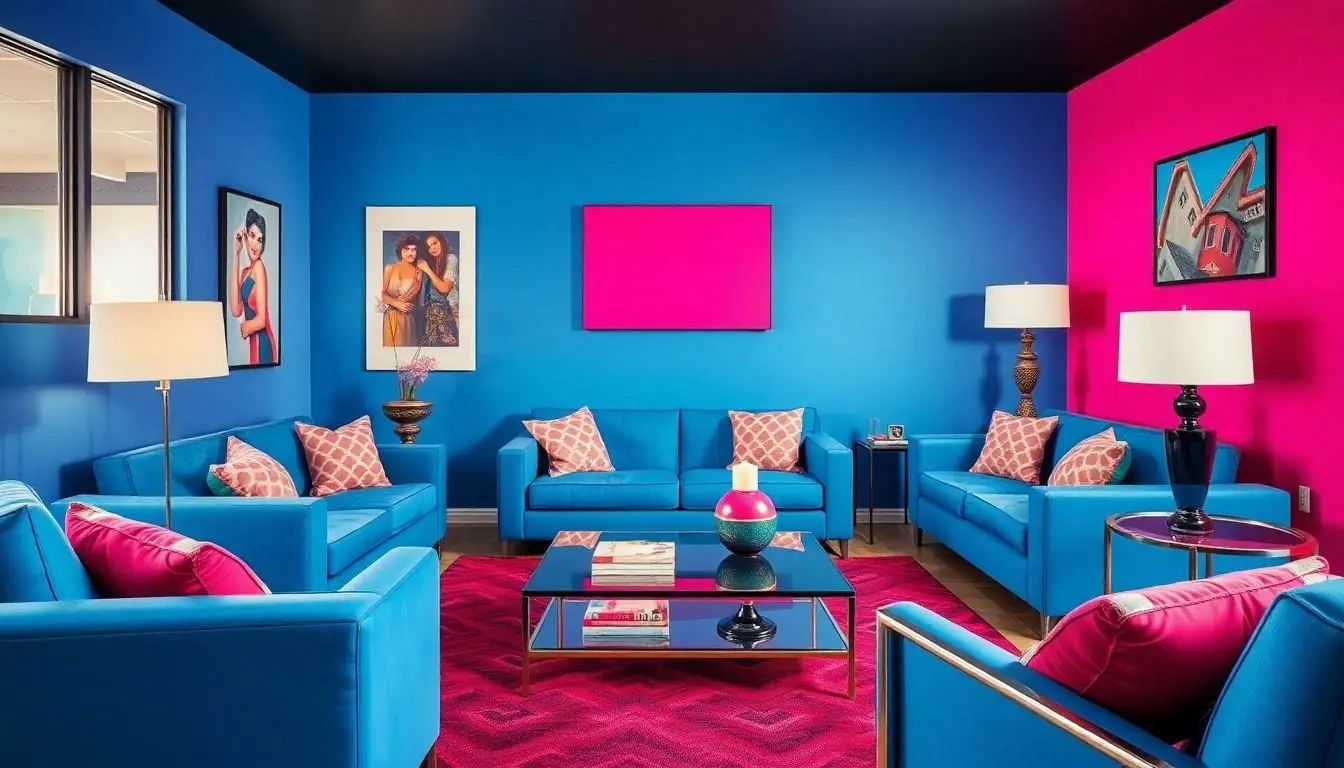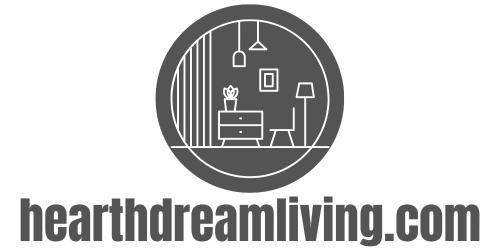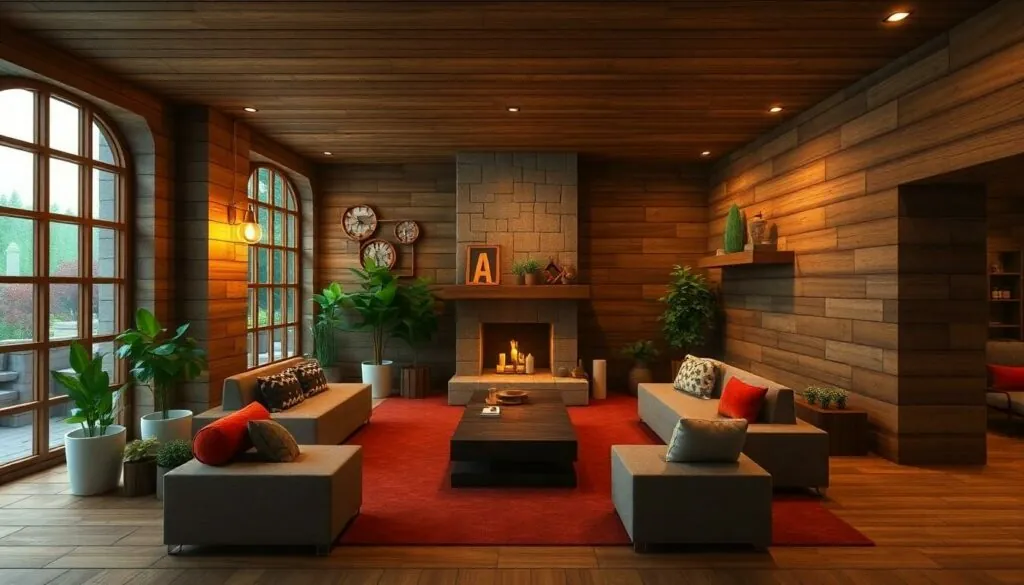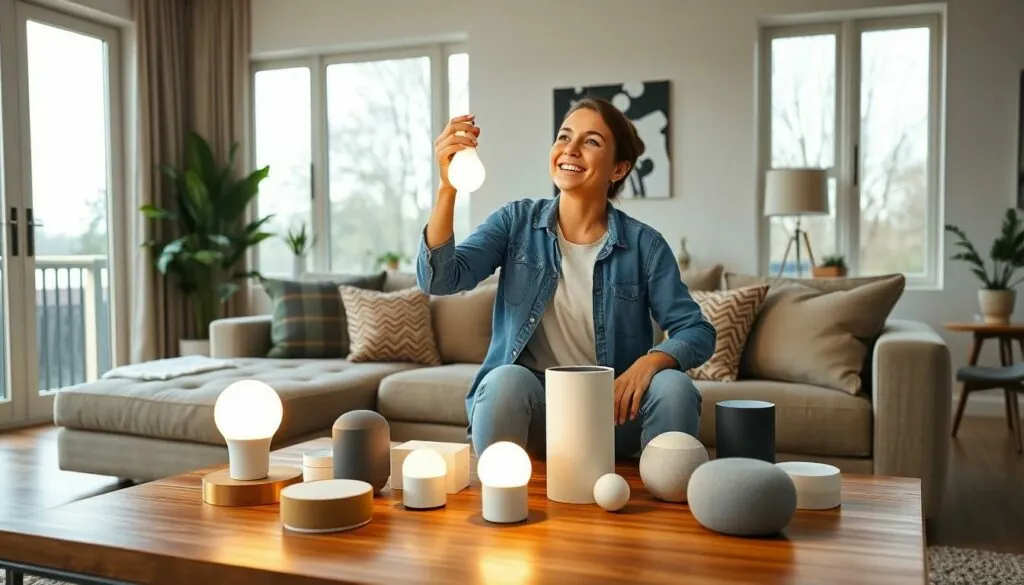Step into the vibrant world of 1980s interior design, where bold colors and eclectic patterns ruled the roost. This was an era when minimalism took a backseat, and maximalism became the name of the game. Think neon hues, geometric shapes, and enough shag carpet to make a yeti jealous. If you ever wondered what it would be like to live inside a Rubik’s Cube, the ’80s had you covered.
From the iconic Miami Vice aesthetic to the cozy charm of country kitchens, this decade was all about self-expression and fun. Whether it was the explosion of pastels or the rise of the infamous waterbed, every detail screamed personality. Dive into this colorful journey and discover how the ’80s still influence today’s design trends, proving that sometimes, the louder, the better.
Table of Contents
ToggleOverview Of 1980s Interior Design
The 1980s interior design showcased an explosion of color and extravagance. Bold hues like electric blue, hot pink, and vibrant green dominated spaces. One distinctive feature was the geometric patterns that adorned walls and textiles; stripes and zigzags added visual interest to rooms. The Miami Vice aesthetic influenced many designs through pastel colors and tropical motifs, bringing a beachy vibe indoors.
Eclectic furniture with mixed materials defined the decade. Pieces often combined metal, glass, and bold fabrics, creating striking contrasts. Waterbeds, a popular trend, symbolized comfort and leisure during this era. Exhibiting a carefree lifestyle, they reflected the decade’s emphasis on relaxation and self-indulgence.
Home decor also embraced unique accessories and art. Oversized artworks and neon signs became commonplace, adding to the vibrant atmosphere. Ornate lighting fixtures, such as chandeliers and sconces, illuminated spaces with flair. Textures varied from glossy finishes to plush fabrics, enhancing the tactile experience of interiors.
Maximalism prevailed over minimalism; individuals expressed their personalities through design choices. Layering patterns and mixing styles became celebrated practices. This bold approach encouraged creativity and comfort, paving the way for future trends.
Today, elements of 1980s design emerge in contemporary decor. The reintroduction of bright colors and geometric shapes highlights the enduring impact of this vibrant decade. As a result, the 1980s continue to inspire those seeking to make bold statements in their homes.
Key Characteristics

1980s interior design features several distinctive elements that define its vibrant style. These characteristics emphasize boldness, creativity, and a commitment to self-expression.
Bold Colors
Vibrant colors dominated 1980s spaces, with shades like electric blue, hot pink, and neon green taking center stage. Interior designers intentionally used these hues to create energetic atmospheres. Accent walls in bright colors became common, adding visual interest to rooms. Furniture pieces also embraced these bold colors, making statements rather than blending in. Color combinations often included high contrasts, enhancing the lively aesthetics of the decade.
Geometric Patterns
Geometric patterns played a significant role in the visual language of 1980s design. Wallpaper, rugs, and fabrics showcased striking shapes, from zigzags to bold stripes. Designers often layered these patterns to achieve a richly textured look. Decorative elements included thick lines and sharp angles, creating a dynamic feel within interior spaces. The playful use of geometry inspired many homeowners to experiment with their design choices, resulting in eclectic and energetic environments.
Unique Materials
Material choices in the 1980s reflected the era’s experimental spirit. Surfaces featured a mix of textures, including glass, metal, and plush fabrics. Waterbeds emerged as a novel furniture solution, exemplifying the decade’s fondness for the unconventional. Upholstery often included a fusion of materials, such as leather combined with vibrant textiles. Designers sought unique materials to evoke a sense of luxury and comfort while incorporating striking contrasts, contributing to the unmistakable character of 1980s interiors.
Popular Styles
The 1980s interior design scene featured a mix of vibrant styles, each contributing to the decade’s unique aesthetic.
Minimalism
Minimalism during the 1980s emphasized simplicity. Clean lines and neutral color palettes defined this style. Furnishings were often functional with a focus on utility. Decorative elements remained subtle, steering clear of excess. Spaces felt open and airy, promoting tranquility and relaxation within homes. This approach countered the louder maxim of the decade while still maintaining a modern appeal.
Maximalism
Maximalism truly represented the spirit of the 1980s. Bold colors filled rooms, creating striking visual statements. Layered patterns adorned walls, furniture, and accessories, encouraging an exuberant mix. Mixing materials was common, with plush textiles paired alongside reflective surfaces. The result created a sense of abundance and energy in spaces. Homeowners embraced dramatic elements, showcasing personality through eclectic combinations that pushed conventional boundaries.
Eclecticism
Eclecticism captured the essence of 1980s design versatility. Mixing influences defined this style, as elements from various cultures coexisted harmoniously. Vintage pieces often complemented modern accents, creating unique environments. Color choices varied widely, with bright and muted tones frequently appearing together. Patterns clashed and harmonized, reflecting individual tastes and inspirations. Homeowners felt empowered to express their identities through diverse designs, ultimately leading to personalized and dynamic spaces.
Iconic Furniture And Decor
The 1980s introduced bold and unique furnishings that defined the era’s eclectic style. Statement pieces became the center of attention in many homes, showcasing individuality and a flair for creativity.
Statement Pieces
Bold furniture choices like oversized sofas and sculptural chairs dominated interiors. These items often featured bright colors and funky patterns, creating visual interest in spaces. Iconic pieces, such as the “banana” and “dinosaur” chairs, stood out as striking conversation starters. Unconventional coffee tables, often shaped like geometric forms, added a playful touch. Many homeowners embraced the idea of unique art installations, bringing color and texture to walls, making every room feel alive. Collectible decor items frequently included the work of famous designers, who influenced trends through their innovative designs.
Lighting Trends
Lighting took on an entirely new character in the 1980s, showcasing eye-catching fixtures. Neon hues found their way into lamps, creating a vibrant ambiance that matched the bold decor. Chandeliers with unique, angular shapes became popular in dining and living areas, emphasizing the maximalist approach. Floor and table lamps often featured elaborate designs, with materials like Lucite and metals lending a modern edge. Many homes showcased track lighting, enabling focused illumination of art and decor, further enhancing the dramatic and colorful interiors that defined the decade. This era’s lighting styles significantly contributed to the overall cheerful and energetic atmosphere seen in 1980s design.
Influence On Modern Design
The impact of 1980s interior design on contemporary decor is significant. Bright colors and geometric patterns from that era reemerged in modern spaces. Designers often incorporate bold hues reminiscent of the time, favoring electric blues, hot pinks, and vibrant greens.
Geometric shapes serve as focal points in today’s designs, echoing the striking styles found in 1980s interiors. Homeowners frequently use these patterns in wallpaper, textiles, and accessories to add dynamism. The creative use of space remains a hallmark of the 1980s, encouraging eclecticism seen in many modern homes.
Textures also play a crucial role in today’s design landscape. The combination of materials like glass, metal, and soft fabrics recalls the adventurous spirit of the 1980s. Unique furniture pieces, such as oversized sofas and sculptural chairs, draw inspiration from that vibrant decade.
Lighting trends further illustrate this influence. Eye-catching fixtures in neon colors and unique shapes reflect the playful aesthetics of the 1980s. Many homes now feature statement lighting that captures the era’s energy while fitting seamlessly into modern design.
Ultimately, the 1980s celebrated individuality and self-expression, themes that continue to resonate. By embracing eclectic designs, today’s homeowners create spaces that showcase their personalities. The willingness to go bold can be seen in the current preference for colorful, maxed-out interiors that connect vibrancy with comfort.
The vibrant world of 1980s interior design continues to inspire and influence modern aesthetics. Its bold colors and geometric patterns invite creativity and self-expression in today’s homes. The eclectic mix of styles from that era encourages homeowners to embrace individuality and create spaces that reflect their personalities.
As contemporary design trends evolve, the playful spirit of the 1980s remains relevant. The fusion of textures and the emphasis on statement pieces offer a refreshing approach to interior decor. Ultimately, the legacy of 1980s design is a celebration of vibrancy and comfort, reminding us that our living spaces can be as dynamic and unique as we are.





